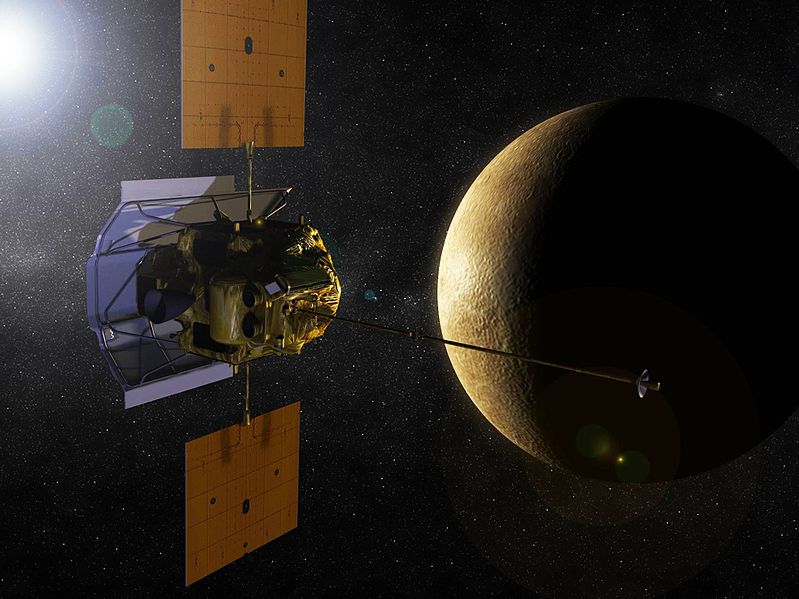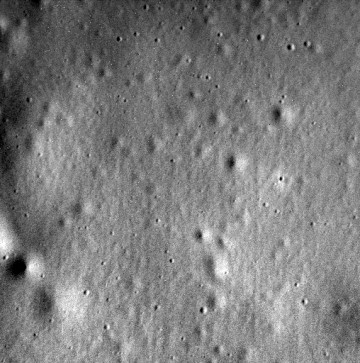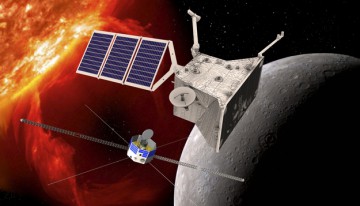
Here’s MESSENGER by the numbers:
Years since launching: 10+;
Years in Mercury’s orbit: Four;
Number of orbits: 4,105;
Size of its impact crater: Estimated to be 52 feet wide;
Other spacecraft to orbit Mercury in spaceflight history: Zero.
What a long, strange trip it has been: NASA’s MErcury Surface, Space ENvironment, GEochemistry, and Ranging (MESSENGER) spacecraft is no more. The space agency’s flagship Mercury mission ended at 3:26 p.m. EDT, as it struck the planet’s surface on its far side at an approximate speed of 8,750 miles per hour. By 3:38 p.m., no signal was detected by the Deep Space Network (DSN) station in Goldstone, Calif.; if MESSENGER had somehow survived, it would’ve emerged from behind Mercury at that time. The mission was declared at its end at 3:40 p.m. The time of impact and end of mission were confirmed by mission controllers at the Johns Hopkins University Applied Physics Laboratory (APL) in Laurel, Md.
NASA’s John Grunsfeld, associate administrator for the agency’s Science Mission Directorate, stated: “Going out with a bang as it impacts the surface of Mercury, we are celebrating MESSENGER as more than a successful mission. The MESSENGER mission will continue to provide scientists with a bonanza of new results as we begin the next phase of this mission— analyzing the exciting data already in the archives, and unraveling the mysteries of Mercury.”

The impact comes after a brief “stay of execution,” as last month, according to the MESSENGER website, “the team embarked on a hover campaign that allowed the spacecraft at its closest approach to operate within a narrow band of altitudes, five to 35 kilometers above the planet’s surface.” This allowed the spacecraft to collect extra scientific data concerning the planet’s polar ice and magnetic qualities. MESSENGER’s mission was intended to last only a year, but adjustments in fuel economy extended the spacecraft’s life by three more. Its final orbital correction maneuver was conducted Tuesday, April 28.
During its four years of orbital operations, MESSENGER shed light upon one of the Solar System’s most enigmatic planets. Mercury, due to its temperature extremes, proximity to the Sun, and exposure to solar radiation, poses a challenge to spacecraft. The planet was previously only explored in three flybys performed by the Mariner 10 spacecraft during the mid-1970s. Up until 2011, no other spacecraft dared to tackle Mercury as its subject of study.
Enter MESSENGER, launched aboard a Delta II 7925 rocket from Cape Canaveral Air Force Station’s SLC-17B on Aug. 3, 2004. Traveling 6.5 years before it entered Mercury’s orbit, the spacecraft mapped Mercury extensively, and also returned evidence of ice water present near its poles.
According to a previous AmericaSpace article, MESSENGER also proved itself to be tough enough to brave the harsh conditions of an alien world: “In addition to its momentous scientific findings, MESSENGER also represented a technological breakthrough in spacecraft design, as it survived a harsh environment for a period much longer than its original lifetime. It employed an innovative ceramic cloth sunshade, designed to protect sensitive spacecraft instruments from extreme temperature excursions. In addition, its orientation was fine-tuned to balance heating conditions.”
Sean Solomon, MESSENGER’s principal investigator and director of Columbia University’s Lamont-Doherty Earth Observatory, gave his thoughts about the end of the mission, while underscoring the intrepid spacecraft’s accomplishments:

“Today we bid a fond farewell to one of the most resilient and accomplished spacecraft ever to have explored our neighboring planets. Our craft set a record for planetary flybys, spent more than four years in orbit about the planet closest to the Sun, and survived both punishing heat and extreme doses of radiation. Among its other achievements, MESSENGER determined Mercury’s surface composition, revealed its geological history, discovered that its internal magnetic field is offset from the planet’s center, taught us about Mercury’s unusual internal structure, followed the chemical inventory of its exosphere with season and time of day, discovered novel aspects of its extraordinarily active magnetosphere, and verified that its polar deposits are dominantly water ice. A resourceful and committed team of engineers, mission operators, scientists, and managers can be extremely proud that the MESSENGER mission has surpassed all expectations and delivered a stunningly long list of discoveries that have changed our views not only of one of Earth’s sibling planets, but of the entire inner Solar System,” he related.
While MESSENGER’s time has come to an end, the spacecraft has left researchers with a treasure trove of data concerning the Solar System’s least-explored planet. Its findings will be available in NASA’s Planetary Data System for years to come. In addition, a new Mercury mission is scheduled to launch in late-January 2017 from Europe’s Spaceport in Kourou, French Guiana, aboard an Ariane 5 launch vehicle. BepiColombo, a joint European Space Agency (ESA) and Japan Aerospace Exploration Agency (JAXA) mission consisting of two orbiters, will identify the impact crater left by MESSENGER when it commences orbital operations in 2024, twenty years after the launch of its U.S. predecessor.
Want to keep up-to-date with all things space? Be sure to “Like” AmericaSpace on Facebook and follow us on Twitter: @AmericaSpace




This was such a great mission, a unique spacecraft with a clever team behind it. (“Well, we’re out of propellant. But we might have some spare helium we can maneuver with…”)
Not bad for a project that cost just $450M after its first year (the length of the primary mission, back in 2011). It’s just one of several examples in the last decade of valuable science & discovery in space that didn’t require multi-billion dollar flagship programs.